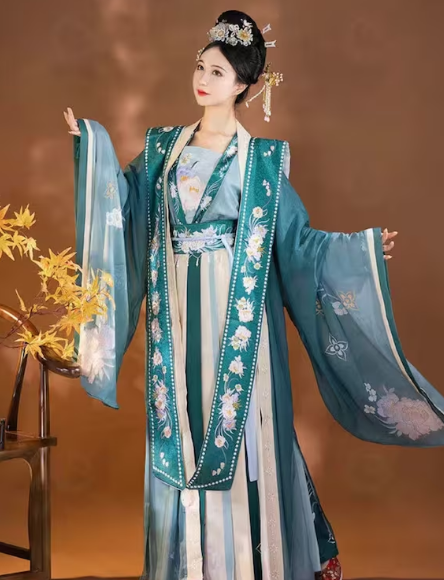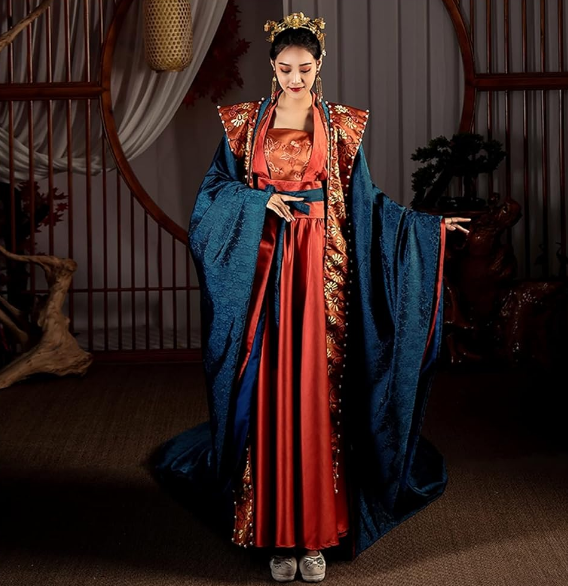Early Dynastic Attire
Shang Dynasty Garments
In the Shang Dynasty, rulers wore elaborate silk tunics to showcase their divine authority. Artisans meticulously wove these garments with intricate patterns, using the finest silks available. The vibrant colors and detailed embroidery in these outfits were not just aesthetically pleasing but also symbolized the empire’s wealth and cultural sophistication.
Zhou Dynasty Style Evolution
During the Zhou Dynasty, royal attire evolved significantly. Emperors and their courts began to incorporate a variety of fabrics, including linens and finer silks. This era introduced layered clothing, with royals wearing multiple garments, each signifying different aspects of their status. The adoption of wider sleeves and looser fits mirrored the changing ideals of elegance and comfort in royal circles.
Throughout these early dynasties, clothing was more than a mere fashion statement; it played a crucial role in the cultural and political landscape. The shift from Shang to Zhou attire vividly demonstrates how changes in governance and society influenced the clothing of those at the pinnacle of the social hierarchy.

Han Dynasty Elegance
Silk Robes and Patterns
In the Han Dynasty, silk robes became symbols of grace and status. Artisans crafted these robes with utmost precision, often incorporating complex patterns that told stories or represented important symbols. The silk itself, known for its lustrous quality and durability, was a prized material. Its production, a closely guarded secret, enhanced the value of these garments significantly.
Accessories and Symbolism
Accessories played a vital role in Han Dynasty fashion. Royalty adorned themselves with intricate jade jewelry, belts with ornamental buckles, and headdresses that signified their status. Each piece of jewelry or accessory carried symbolic meanings. For instance, jade represented purity and moral integrity, while specific headdress designs could indicate the wearer’s rank or achievements.
Han Dynasty elegance was not just about visual appeal; it was a sophisticated language of symbols and status. The combination of luxurious silk robes and meaningful accessories created an aesthetic unique to this era, reflecting the dynasty’s prosperity and cultural depth.
Tang Dynasty Extravagance
Influence of Foreign Styles
In the Tang Dynasty, the interaction with foreign cultures brought a new wave of styles into royal fashion. Royals began incorporating elements from Central Asia and Persia, evident in the vibrant colors and elaborate patterns of their garments. This period saw the introduction of wider sleeves and higher waistlines, influenced by the cosmopolitan nature of the Tang capital, Chang’an.
Innovations in Fabric and Design
This era also witnessed remarkable innovations in fabric and design. Artisans experimented with new weaving and dyeing techniques, resulting in richer, more varied textures and colors. The use of gold and silver threads became popular, adding a luxurious sheen to the garments. Embroidery reached new heights of complexity, often depicting intricate scenes from nature or mythology.
Tang Dynasty extravagance was a blend of domestic innovation and foreign influences, creating a fashion legacy that is celebrated for its opulence and artistic sophistication.
Song Dynasty Refinement
Gender Differences in Royal Attire
In the Song Dynasty, royal attire distinctly varied between genders. Men’s clothing emphasized simplicity and elegance, often featuring long robes with minimalistic designs. Women’s attire, on the other hand, showcased more complexity and ornateness, with layers of robes, intricate patterns, and delicate accessories. This divergence in style underscored the different societal roles and expectations of men and women in the royal court.
The Role of Color and Embroidery
Color and embroidery played significant roles in Song Dynasty fashion. Artisans used color to signify rank and status, with certain hues reserved exclusively for royalty. Embroidery, often featuring floral and nature motifs, added depth and texture to garments. Each stitch and color choice was deliberate, transforming simple fabrics into works of art that conveyed messages of power, sophistication, and cultural pride.
Song Dynasty refinement was not just about aesthetics; it was a careful balance of form, function, and symbolism. The era’s clothing styles mirrored the cultural values and artistic sensibilities of the time, with each element of attire serving a purpose beyond mere decoration.
Ming Dynasty Opulence
The Dragon Robe and Imperial Identity
In the Ming Dynasty, the dragon robe became a symbol of the emperor’s supreme power. This magnificent garment featured nine dragons, embroidered with gold and silver threads, representing the emperor’s connection to the celestial realm. The dragons, set against a background of clouds and waves, symbolized the emperor’s command over all natural elements. Only the emperor had the privilege to wear such a robe, making it a distinct emblem of imperial identity.
Hats, Belts, and Ceremonial Attire
Hats and belts in the Ming Dynasty were more than mere accessories; they were integral to royal and ceremonial attire. Officials wore specific hats denoting their rank and position, often adorned with jade and precious stones. Belts, too, were elaborate, often made of silk and decorated with intricate buckles. These accessories, along with the formal robes, completed the ceremonial attire, reflecting the wearer’s status and the solemnity of the occasion.
Ming Dynasty opulence was a display of power, tradition, and artistry. Each element of the royal attire, from the dragon robe to the accessories, was a testament to the dynasty’s wealth, cultural pride, and meticulous craftsmanship.
Qing Dynasty Complexity
Manchu Influence on Royal Dress
In the Qing Dynasty, the Manchu influence profoundly reshaped royal dress. The rulers adopted the Manchu-style robe, known as the “Qipao” or “Cheongsam,” characterized by its straight lines and high collar. This style signified a departure from the flowing silhouettes of previous dynasties, reflecting the Manchu’s influence and the political shift of power. These garments, while preserving traditional Chinese motifs, adopted a more practical and less voluminous design, suitable for the Manchus’ equestrian lifestyle.

The Use of Jade, Pearls, and Other Precious Materials
The Qing Dynasty also saw an increased use of jade, pearls, and other precious materials in royal attire. Emperors and empresses adorned their clothing and accessories with these materials, not just for their beauty but also for their symbolic meanings. Jade represented purity and moral virtue, while pearls were symbols of wealth and nobility. These materials were often intricately incorporated into headdresses, jewelry, and even the robes themselves, showcasing the dynasty’s wealth and refined taste.
Qing Dynasty complexity was a blend of political, cultural, and aesthetic changes. The adoption of Manchu styles and the lavish use of precious materials in clothing reflected the dynasty’s diverse cultural influences and its commitment to showcasing imperial power and prestige.







